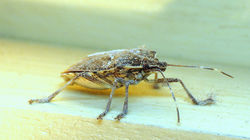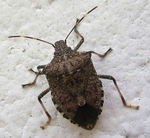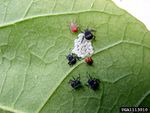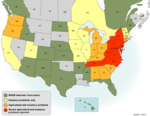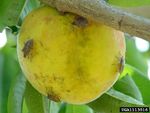Brown marmorated stink bug
| Brown marmorated stink bug |
|---|
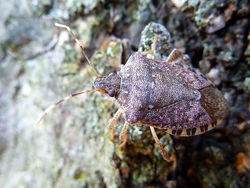
|
| Scientific Classification |
|
| Scientific name |
|
Halyomorpha halys |
| Brown marmorated stink bug |
Brown marmorated stink bug is a species of stink bug known by the scientific name Halyomorpha halys. They are an invasive species that came from Asia and can be easily recognized by it's black and white stripes on its antennae in adult stage. It might have came from shipping in Asian countries. They first appeared in Pennsylvania, and have spread to multiple other states. It feeds on crops so it is considered an agricultural pest in both America and it's native habitat. There have been may attempts to control them but there are only some promising results.
Body Design
When Brown marmorated stink bugs are born they will have a orange or yellowish red body coloring and they are about 2.4 mm, there body will change into a black color after there second molting or stage. They will slowly grow bigger to a size of 12 mm when they reach the final stage in nymph stage, they will molt into an adult which is the final stage of the brown marmorated stink bug. An adult stink bug could grow to a size of 17mm, some of the ways to spot an adult brown stink bug is it's black and white band on it's antennae which is some of it's most distinguishing characteristics there are also some white bands on it's legs. They also have a shield shaped body and have a scent gland under it's stomach. [2]
Life Cycle
The Brown marmorated stink bug or BMSB are the eggs. They are usually laid a lot during the summer specifically from May through August. The eggs are usually laid in places with heavy cover or in houses and will hatch in about four to five days. The second stage which is the nymph, but the Brown marmorated stink bug has 5 stages of nymph to go through which takes a week to through a stage. During the nymph stage they will feed on nearby leafs, vegetables,etc... after they molt for the fifth time they will reach the last stage. The last stage is Adult, after they have matured they will continue to eat plant life until October is when they start to find places to hibernate during the winter. During November and December they will go into hibernation then later come out during January to continue to feed till April which is when they will start to mate again restarting the whole process. A Brown marmorated stink bug can live from six to eight months.[3]
Ecology
Brown marmorated stink bug originates from China, Taiwan, Japan and other South East Asia countries.The brown marmorated stink bug is considered a pest in it's native habitat and in the United States both indoors and outdoors. The reason for this is that it feeds on vegetables, fruit and other plant life and even crops of farmer in Asia, it feeds by piercing the skin of the apple and sucking all of the juice out making it not fresh, covered with the beetle odor from it's scent glands and making it rotten in the inside making it unable to sell on the market. This could make the agriculture industry crumble it is not taken care of, if there wasn't any one trying to stop them most of the fruit of the country would have been gone by now. Besides being a pest to the crops it is also an annoyance in to houses that are near the area where they were born because they will infest the house during the winter to hibernate because they need places heavy cover places to hibernate . They will usually look for houses or other buildings to get in, and because it leaves a smelly odor when sweep away or touched it make it's annoying to be in someone or anyone house. The native predator of the brown marmorated stink bug is in Asia but there are some predators in the States that feed on them such as predator stink bugs and parasitoids.[4]
Invasive Species
Location and Method of Introduction
Brown marmorated stink bugs are native to China and other Southeast Asia countries such as Korea and Japan. They feed on crops and fruits so they considered a pest both in their native habitat and in the United states as well.The first sighting of them in America was in Allentown, Pennsylvania and they could have gotten in the States in shipping cargo from China or other Southeast Asia countries.Now they have spread to multiple states all over America, they are very harmful to our crops so we must exterminate them if we don't want any fruit or vegetables shortages.[5]
Environmental Impact
Brown marmorated stink bugs is a dangerous invasive species because they feed on almost any crops so they could spread very easily cause they don't need any specific food source as long it it vegetables or fruits, they feed on the fruit by sucking out all of it juices making the fruit rot. They can easily spread so if we didn't take care of them when they started to populate their would have already been a lot of place with fruit shortages but luckily we are able to control them for now. The lost of many crops could lead to food shortages, when they reproduce they also go into homes or man made structures destroying them in the process.[6]
Control Methods
If your house has been infected with brown marmorated stink bugs you can temporarily solve it by using insecticide and covering up the places that they came from usually from cracks in walls or near windows. Although that method will not stop them from invading your house and is not recommended because insecticide is poisonous, if you want to get rid of them you could call pest control to kill the bugs that are near your house and that will hopefully stop them. For farmers you could always spray insecticide but that will harm the crops that they are growing but overtime their resistance of the insecticide will grow making them less effective. Another way of stopping them is to introduce a new predator to take care of them, parasitoid wasps and assassin bugs has been used to help control the brown marmorated stink bugs population. Using all of these methods scientist could find a way to exterminate them permanently.[7]
Video
Scientist attempts to fight back brown marmorated stink bugs
References
- ↑ Halyomorpha_halys Wikispecies. Last modified November 4 2015. Unknown author.
- ↑ Daugherty, Matt. Brown Marmorated Stink Bug (Halyomorpha halys) University of California, Riverside. Last accessed January 5, 2017.
- ↑ Gyeltshen, Jamba. Entomology&Nematology University of Florida. Published on April, 2005.
- ↑ Jacobs, Steve. Brown Marmorated Stink Bug Pennstate college of agricultural sciences. Last revised February, 2015.
- ↑ Brown marmorated stink bug West Virginia University. Last modified in September 19,2016. Unknown author.
- ↑ Brown marmorated stink bug National wildlife federation. Last accessed January 18,2017. Unknown author.
- ↑ Brown marmorated stink bugs EPA. Accessed on January 18, 2017. Unknown author.
